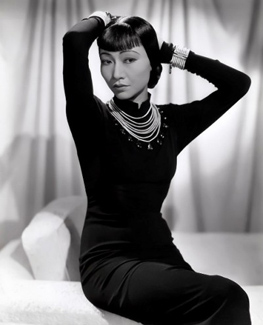Product Description
Carl van Vechten “Anna May Wong” 1932


CARL VAN VECHTEN (1880-1964) USA
Anna May Wong 1932
Signed: Anna May Wong 1932 (in pencil on back); PHOTOGRAPH BY CARL VAN VECHTEN CANNOT BE REPRODUCED WITHOUT PERMISSION (ink stamp on back)
Size: H: 9 7/8”x W: 7 7/8”
Anna May Wong (1905 – 1961) was the first Chinese American actress to become a movie star in a career that spanned both the silent movie era and the advent of the talkies, along with starring roles on the stage, and in radio and television, even hosting her own television show at one point. This is all the more remarkable considering the racist times in which she worked. Many Asian actresses have been acclaimed since, under less adverse conditions, but none have reached Wong’s level. Some of her more notable silent movies include a leading role in The Toll of the Sea, one of the first color movies, The Thief of Bagdad, which starred Douglas Fairbanks, and Piccadilly. She was also featured in some notable talkies, including Shanghai Express, which co-starred Marlene Dietrich, and Daughter of the Dragon, in which she starred opposite an Asian leading man, Sessue Hayakawa. Early in her career, she was seen as a sex symbol, a feat other Asian actresses would not match for decades.
Carl van Vechten “Anna May Wong” 1932
HERBERT BAYER (1900-1985) Austria
Self portrait 1932 (printed later)
Silver gelatin print
Edition: 28/40
Signed: bayer 32 (in ink on bottom right corner)
Provenance: Kennedy Gallery, New York
H: 13 7/16” x W: 9 ½”
Framed size: H: 21 ½” x W: 17 ½”
Price: $16,000
Herbert Bayer (1900 – 1985) was an Austrian graphic designer, painter, photographer, and architect. Bayer apprenticed under the artist Georg Schmidthammer in Linz. Leaving the workshop to study at the Darmstadt Artists’ Colony, he became interested in Walter Gropius’s Bauhaus manifesto. After Bayer had studied for four years at the Bauhaus under such teachers as Wassily Kandinsky and László Moholy-Nagy, Gropius appointed Bayer director of printing and advertising. In the spirit of reductive minimalism, Bayer developed a crisp visual style and adopted use of all-lowercase, sans serif typefaces for most Bauhaus publications. Bayer is one of several typographers of the period including Kurt Schwitters and Jan Tschichold who experimented with the creation of a simplified more phonetic-based alphabet. Bayer designed the 1925 geometric sans-serif typeface, universal, now issued in digital form as Architype Bayer that bears comparison with the stylistically related typeface Architype Schwitters.
In 1928, Bayer left the Bauhaus to become art director of Vogue magazine’s Berlin office. He remained in Germany far later than most other progressives. In 1936 he designed a brochure for the Deutschland Ausstellung, an exhibition for tourists in Berlin during the 1936 Olympic Games. In 1938 he left Germany and settled in New York City where he had a long and distinguished career in nearly every aspect of the graphic arts. In 1946 Bayer relocated again. Hired by industrialist and visionary Walter Paepcke, Bayer moved to Aspen, Colorado as Paepcke promoted skiing as a popular sport. Bayer’s architectural work in the town included co-designing the Aspen Institute and restoring the Wheeler Opera House, but his production of promotional posters identified skiing with wit, excitement, and glamour. Bayer would remain associated with Aspen until the mid-1970s. Bayer gave the Denver Art Museum a collection of around 8,000 of his works. In 1959, he designed his “fonetik alfabet”, a phonetic alphabet, for English. It was sans-serif and without capital letters. He had special symbols for the endings -ed, -ory, -ing, and -ion, as well as the digraphs “ch”, “sh”, and “ng”. An underline indicated the doubling of a consonant in traditional orthography.
CARL VAN VECHTEN (1880-1964) USA
Pearl Bailey
Signed: PHOTOGRAPH BY CARL VAN VECHTEN, 101 CENTRAL PARK WEST, CANNOT BE REPRODUCED WITHOUT PERMISSION (ink stamp on back); VII . CC . 12 (in ink on back)
Size: H: 9 15/16” x W: 7 15/16”
Pearl Mae Bailey (March 29, 1918 – August 17, 1990) was an American singer and actress. After appearing in vaudeville, she made her Broadway debut in St. Louis Woman in 1946. She won a Tony Award for the title role in the all-black production of Hello, Dolly! in 1968. In 1987, she won a Daytime Emmy award for her performance as a fairy godmother in the ABC Afterschool Special, Cindy Eller: A Modern Fairy Tale. Her rendition of “Takes Two to Tango” hit the top ten in 1952.
Carl Van Vechten (June 17, 1880 – December 21, 1964) was an American writer and photographer who was a patron of the Harlem Renaissance and the literary executor of Gertrude Stein. Van Vechten took photographs of many the major artists and intellectuals of the first half of the 20th century. The importance of these images is twofold; they document a specific time and milieu in 20th-century American history that was neglected by others, and they are among some of the earliest art photography images created.
